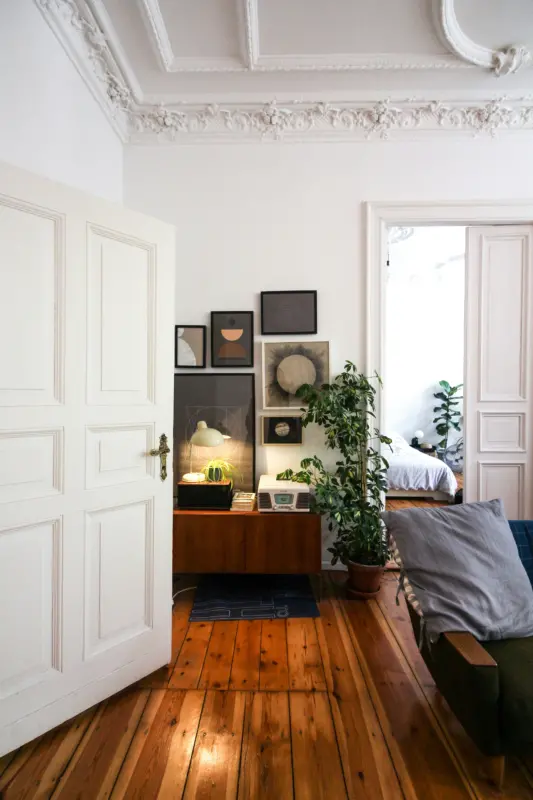Interior doors can be installed everywhere – in private houses, apartments, offices, shops, and even governmental institutions. Their principal role is room dividing, creation, and designation of a separate space. But not less frequently, they are an essential element in the room design. Thanks to a wide variety of models, now you can choose a door structure in any style and for different tastes. Slabs differ not only in appearance but in the materials from which they are made. The installation place, duration of service, and design options depend on them.
In this article, we will look at what modern doors are made of and how they differ.
The main types of interior door slabs
Solid wood. The classic version of products for a house or apartment. Good insulating properties distinguish such models; they serve for many years, although they require rather complicated maintenance and attention. Doors are made of wood in the spirit of Empire, Renaissance, Gothic, Provence, and other styles. They even tolerate rough processing – milling, artistic carving.

Glass. Unusual modifications are gradually gaining more and more popularity. They are perfect for furnishing bathrooms, living rooms, offices where serious sound insulation is not required. They stand out for their design complexity, variety of décor. Almost any picture can be applied. They serve for many years, do not imply challenging maintenance.

Veneer. An excellent alternative to solid wood, especially where it is impossible to install wooden doors due to their weight. In addition, these models are natural, environmentally friendly, and safe. There are several varieties of such coatings, which are divided into categories by price and manufacturing methods.

Laminate. Decent and economical replacement for the previous version. Perfectly imitates the color and pattern of wood, can be in different shades. It is applied on chipboard, does not tolerate moisture and mechanical damage. In this way, models are made out without milling and other decor; it is replaced by the imposition of a baguette or a curly wooden frame.

PVC film. An option for those who want to save money is looking for models with a more sophisticated design. PVC can be made in any color, including repeating the shade, pattern of the natural solid wood. Looks neat, does not require complex care. The coating is resistant to moisture, shock, and other influences. It is applied on MDF, including milled ones. They have a long service life.

Painted. Enamel is one of the fashionable novelties that is gaining more and more fans. Quite laborious to apply, but at the same time, it stands out for its originality, durability, and resistance to damage. There is an impressive selection of shades to complement interiors in a variety of styles. On the surface, it creates a unique, mirror-like matte or glossy film.

Additional materials for finishing
When decorating interior doors, especially some of their parts, different materials can be used, including:
· Aluminum – as an overlay on the ends to protect them from adverse factors.
· A baguette is a carved frame that is used to decorate and fix glass or mirror inserts.
· Panels – this is how modern combined models are created, where elements from MDF are used in place of inserts, and the frame is made of pine beams.
· Stained glass – different complexity and type, allow production doors designs in various styles.
How to choose an interior door?
Before you buy any of the products, it is worth understanding that none of them are designed for use outdoors or under challenging conditions. Otherwise, they are unlikely to last more than 2-3 years and will require replacement. If it is assumed that the product is needed to stay for much longer, the selection of a suitable material is carried out by the following parameters:
· The room, where the door will be installed
· Estimated period of service.
· Purpose – part of the interior or just the door slab.
· The presence of children and pets in the home can damage the product or be injured by it.
· The role and importance of heat and sound insulation.
· Affordable cost of one slab with all accessories and installation.
Not only the decor depends on this, but also the material of production.
How to check the quality of the material?
To ensure that the interior door will last the entire promised period, it is advisable to make sure that it is made of the declared material and has no defects.
· Tap on the body of the product. Dull sound – indicates uniform filling, distribution of insulating inserts. Voiced – suggests the presence of voids between the sheets of MDF or chipboard. This option is less reliable and durable.
· Examine the interior door. Glue marks, irregularities, unexpected protrusions, and other little things indicate poor production quality.
· Measure the design. The discrepancy between the diagonals should not exceed 1/20 inch. If this number is much higher, then the product will not fit into the box.
How to distinguish a good slab from a fake one?
It is not so challenging to identify low-quality veneer, laminate, or PVC:
· Traces or marks must remain on the veneered surfaces when pressed. The presence of delaminated fibers is not allowed.
· Uneven surface on a laminated door is a clear indicator of poor quality.
· An unpleasant, exceptionally intense smell indicates poor-quality adhesives that are used to create structures.
· There should be no bubbles or oil stains on the glass
· Decorative elements, like the coating itself, must be firmly fixed.

 All Interior Doors
All Interior Doors Prehung Doors
Prehung Doors Doors By Style
Doors By Style Doors By Room
Doors By Room Sliding Doors
Sliding Doors Doors By Color
Doors By Color Bi-Fold Doors
Bi-Fold Doors French Interior Doors
French Interior Doors All Exterior Doors
All Exterior Doors Steel Security Doors
Steel Security Doors Fiberglass Doors
Fiberglass Doors Wrought Iron Doors
Wrought Iron Doors Aluminum Windows
Aluminum Windows Vinyl Windows
Vinyl Windows Wood Windows
Wood Windows Tables
Tables Accessories
Accessories Magic Door Hardware
Magic Door Hardware Magnetic Door Hardware
Magnetic Door Hardware Entry Handle sets
Entry Handle sets Barn Door Hardware
Barn Door Hardware Pocket Door Hardware
Pocket Door Hardware Door Levers
Door Levers Magnetic Locks
Magnetic Locks Hinges
Hinges Bathroom Mirrors
Bathroom Mirrors Wall-Mounted Vanities
Wall-Mounted Vanities
















 Steel Security Doors
Steel Security Doors